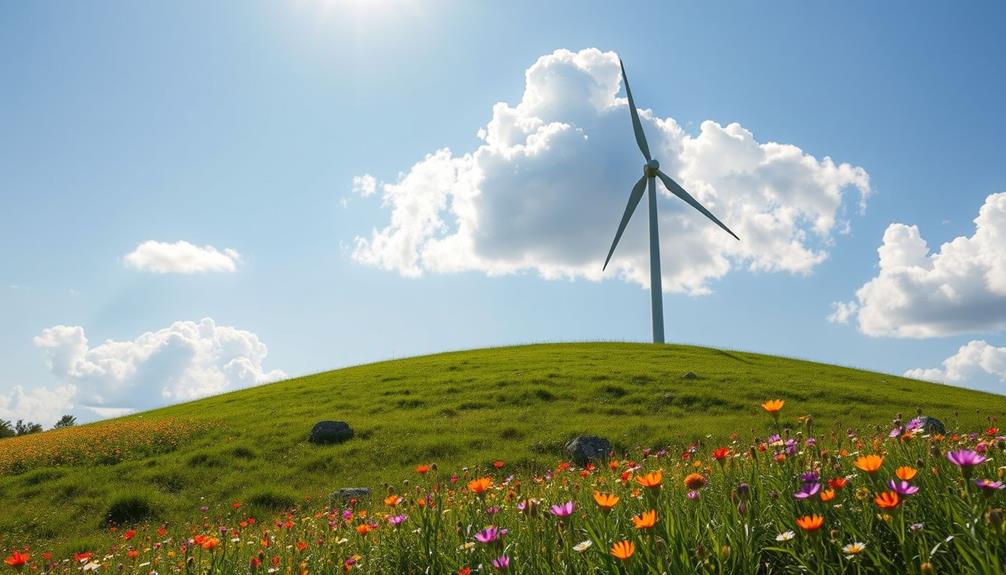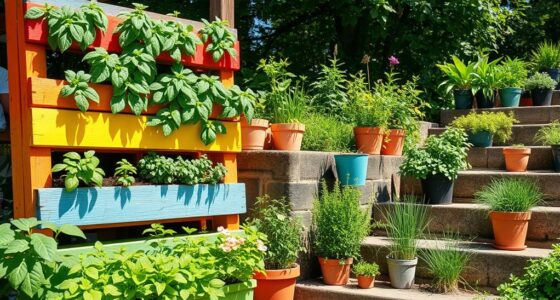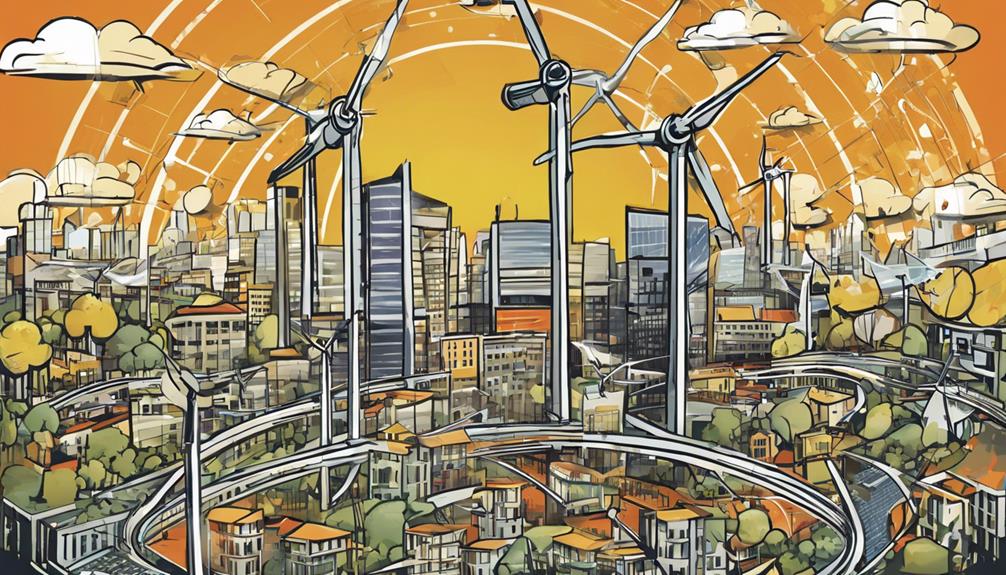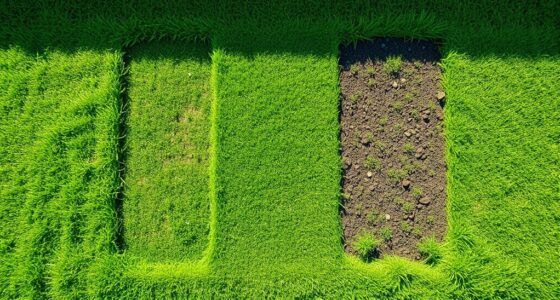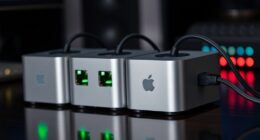Home wind turbines let you harness wind power to produce up to 1,500 kWh of energy annually. By generating your own electricity, you can greatly cut utility bills and gain energy independence. These innovative systems operate even at low wind speeds, making them effective in various conditions. Installing a home wind turbine can cost around $6,500, but financial incentives may offset up to 30% of that expense. Plus, with advancements in design, these turbines continue to improve efficiency and reduce maintenance needs. Discover how you can take control of your energy future and the different options available.
Key Takeaways
- Home wind turbines can produce up to 1,500 kWh annually, significantly reducing energy costs and providing energy independence.
- Installation costs average around $6,500, but tax incentives can offset up to 30% of these expenses.
- Key components include rotors, towers, nacelles, and generators, essential for efficient energy conversion.
- Innovations like the Axial Flux Turbine allow for silent operation and effective energy generation at low wind speeds.
- Utilizing renewable energy from home wind turbines minimizes greenhouse gas emissions, supporting a sustainable future.
Overview of Home Wind Turbines

Harnessing the power of wind, home wind turbines provide a sustainable way to generate electricity for your household. These innovative devices, like the WindTronics turbine, can produce energy day and night, as long as there are consistent wind patterns.
With the potential to generate up to 1,500 kWh annually, they offer a promising solution for reducing your energy costs. Additionally, the weight of these turbines can vary considerably, impacting their installation and efficiency, making it essential to choose models that suit your environment and needs.
Weight of Wind Turbine Blades affects transportation logistics. While the initial installation of home wind turbines can average around $6,500, the long-term savings on electricity bills can be considerable. Plus, many models, including the WindTronics turbine, have low startup wind speeds, beginning power generation at just 0.5 mph. This capability makes them effective even in varying wind conditions.
You can also enhance the efficiency of home wind turbines by combining them with solar panels, creating a hybrid renewable energy system. This combination guarantees a more reliable power supply, particularly useful for off-grid living.
Benefits of Generating Your Own Power

When you generate your own power with home wind turbines, you can enjoy significant cost savings on your utility bills.
This not only gives you energy independence but also helps reduce your environmental impact by cutting down on fossil fuel use.
Additionally, utilizing renewable energy sources like wind can contribute to a healthier planet by minimizing greenhouse gas emissions, as outlined in cold medications overview.
Embracing wind energy not only benefits your wallet but also supports a sustainable future.
Cost Savings on Utilities
Generating your own power with a home wind turbine can lead to substantial cost savings on your utility bills, giving you more control over your energy expenses. Many users report saving 50% or more compared to traditional utility costs.
By investing in a wind turbine, you're not only cutting monthly electricity bills but also setting yourself up for long-term financial benefits. Some systems show a return on investment within just 5 to 10 years due to reduced reliance on grid electricity.
Additionally, utilizing renewable energy sources like wind can provide tax advantages similar to those found with gold IRAs.
Furthermore, home wind turbines often qualify for various federal and state tax incentives, allowing you to offset up to 30% of installation costs. This means even greater cost savings on utilities.
When you produce renewable energy on-site, you can hedge against rising utility rates, enjoying more predictable energy costs that enhance your financial security.
In particularly windy regions, a small wind turbine can generate enough energy to power your entire home, potentially eliminating your electricity bill altogether.
Ultimately, by harnessing wind energy, you're not only saving money but also contributing to environmental sustainability.
Energy Independence Achieved
Investing in a home wind turbine not only cuts your utility costs but also empowers you with significant energy independence. By generating your own power, you can drastically reduce your reliance on traditional energy sources. Unlike solar panels, which only generate electricity during daylight hours, home wind turbines can produce energy 24/7, maximizing your energy output year-round.
Modern turbines, like the Avatar™, can generate up to 5 kWh daily even at average wind speeds of just 5.5 m/s, making them efficient in various conditions. Here's a quick look at how you can benefit:
| Benefit | Description | Impact |
|---|---|---|
| Energy Generation | Produces power around the clock | Consistent electricity |
| Cost Savings | Average installation cost around $6,500 | Long-term financial gain |
| Reliability | Reduces vulnerability to energy price fluctuations | Greater stability |
| Energy Independence | Decreases reliance on utility companies | Control over energy use |
| Efficiency | Works well in lower wind conditions | More accessible options |
With these advantages, achieving energy independence becomes not just a dream, but a reality.
Environmental Impact Reduction
Home wind turbines consistently provide an effective way to reduce your environmental impact while generating your own power. By harnessing wind energy, you can greatly decrease your reliance on fossil fuels, which leads to lower greenhouse gas emissions and helps combat climate change.
In 2022 alone, wind energy generated 2.1 trillion kWh globally, contributing to substantial reductions in CO2 emissions. Additionally, incorporating modern energy-efficient systems like the ultimate heat pump can further enhance your home's energy savings and comfort.
When you invest in a home wind turbine, you not only promote sustainability but also enjoy personal benefits:
- Lower utility bills: Generating electricity on-site means you consume less energy from traditional power grids.
- Energy independence: Utilizing local wind resources empowers you to take control of your energy needs.
- Carbon footprint reduction: Every kWh of wind energy you produce cuts down the harmful emissions that contribute to climate change.
Key Components of a Wind Turbine

A wind turbine's key components work together to harness the power of the wind and convert it into usable electricity. Understanding these components is crucial for maximizing your wind resources effectively.
| Component | Function | Significance |
|---|---|---|
| Rotor | Captures wind energy | Efficiency and energy conversion |
| Tower | Supports the turbine at height | Access to higher wind speeds |
| Nacelle | Houses generator and controls | Critical for operational management |
The rotor typically has three long blades, designed for efficiency with streamlined shapes that minimize drag. The tower, ranging from 50 to 200 meters high, guarantees that your turbine can tap into stronger winds, enhancing energy production. Additionally, the nacelle contains essential components like the gearbox, which converts rotor motion into electricity, and smart technology that manages operations. This technology activates the turbine at wind speeds of 8-16 mph and shuts it down at 55 mph to prevent damage during extreme conditions. By understanding these key components, you can better appreciate how a wind turbine generates power for your home.
Step-by-Step Construction Guide

When you're ready to build your home wind turbine, start by gathering the essential components needed for construction.
Understanding the importance of budgeting for this project can help you allocate funds effectively, ensuring you can cover the costs associated with creating a personal budget.
You'll follow a clear process to assemble the turbine, ensuring each part fits together securely.
Essential Components Needed
To successfully construct a home wind turbine, you'll need several essential components that work together to harness wind energy effectively.
Toilet maintenance is vital for guaranteeing a smooth operation, much like the proper assembly of your turbine.
Here's a quick rundown of what's necessary for your small wind turbine project:
- Generator: A surplus permanent magnet DC motor serves as the heart of your turbine, converting wind energy into electrical power.
- Blades: You can craft blades from PVC or ABS pipe. They should be 6 inches in diameter and 24 inches long, shaped into airfoils for peak performance.
- Mounting System and Tower: Use simple materials like 2×4 wood and PVC piping for the mounting system. An iron pipe or EMT conduit will provide stability and ease of raising and lowering your turbine.
Additionally, you'll need a hub to connect the blades to the generator, typically made from a toothed pulley and aluminum disk, secured with bolts for stability.
Don't forget a custom charge controller to manage power flow from the turbine to the batteries.
With these essential components needed, you're well on your way to generating your own power!
Construction Process Overview
Getting started on your home wind turbine project involves a systematic approach that guarantees each component is carefully assembled for best performance.
First, acquire a suitable generator; a surplus permanent magnet DC motor, like the 30-volt Ametek motor, is a cost-effective choice that can generate several hundred watts of wind energy. In recent years, there's been a growing demand for sustainability and responsible investing, which makes home wind turbines an attractive option for eco-conscious homeowners.
Next, construct the turbine blades using 6-inch diameter black ABS pipe. Shape them into airfoils for enhanced performance, creating a total of four blades, including a spare.
After that, build a hub to connect the blades and motor. Use a toothed pulley and aluminum disk, securing everything with drilling, tapping, and bolting techniques to guarantee stability.
Then, assemble the turbine mounting and tower base. Combine PVC pipe for weather shielding with a sturdy structure made from iron pipe and EMT conduit for durability.
Finally, erect the tower, making sure to align it properly with turnbuckles. Don't forget to integrate the electronics to manage the power flow to your battery system efficiently.
Following these steps will help you harness wind energy effectively and set the foundation for your sustainable energy project.
Testing and Evaluation Steps
Testing and evaluating your home wind turbine is essential for ensuring it operates efficiently and safely once installed. Start by selecting a suitable generator, like a surplus permanent magnet DC motor. Testing the output of your generator is vital for verifying its performance before integrating it into your turbine design.
Additionally, using energy-efficient components can contribute to a more sustainable setup, aligning with the benefits of energy-efficient appliances. Next, construct turbine blades from black ABS pipe shaped into airfoils, aiming for a diameter of 6 inches and a length of 24 inches for peak performance.
Here are some key steps to follow during your evaluation:
- Assemble the hub using toothed pulleys and aluminum disks, securing everything with drilling, tapping, and bolting techniques.
- Build a sturdy tower base with plywood and pipe fittings, ensuring it's easy to raise and lower while maintaining stability.
- Incorporate a custom charge controller to manage power flow, set voltage thresholds, and monitor battery charging status with visual indicators.
Testing the Wind Turbine

The successful testing of the wind turbine head unit demonstrated its ability to achieve high rotational speeds outdoors, even in windy conditions. During these tests, you'll notice that the unit can reach impressive speeds without any load on the generator, which is a promising indication of its performance.
Electric bike generators, which convert pedaling into renewable energy, also showcase similar efficiency in harnessing power, making them ideal for sustainable energy projects. However, safety measures were vital. Holding the spinning unit raised concerns, leading to the decision to control the spinning by redirecting the head out of the wind.
Your turbine system features a custom charge controller that plays an essential role in monitoring battery voltage and managing power flow between the turbine and batteries. You set the voltage thresholds for the charge controller at 11.9V (low) and 14V (high) to guarantee proper operation and prevent erratic behavior during varying wind speeds.
Throughout the testing process, using a multimeter allows you to measure voltage levels accurately, guaranteeing you keep a close eye on the system's performance and charging status.
This thorough testing phase not only validates the turbine's capabilities but also sets the stage for successful integration into your power system.
Installation and Setup Process

After successfully validating the turbine's performance, it's time to focus on the installation and setup process.
Start with a thorough site assessment to evaluate consistent wind patterns and guarantee you comply with local zoning laws. This step is vital to avoid future headaches. Additionally, consider the energy needs of your household to determine the appropriate turbine size for maximum efficiency, similar to how wood pellet fireplaces efficiently manage heat output through automated systems.
Next, you'll want to implement proper safety measures during the erection of the wind turbine tower. Secure anchoring and alignment techniques will guarantee stability and safety during operation. Selecting durable materials for the tower and mounting systems, like steel conduit and plywood, is essential for withstanding environmental conditions.
Once the physical setup is complete, pay attention to the electronics. Confirm that the battery, inverter, and charge controller are correctly connected for efficient energy transfer and to prevent potential damage.
Here are a few key considerations for your installation and setup process:
- Perform a site assessment for maximum turbine placement.
- Use durable materials for long-lasting support.
- Regularly monitor and maintain components for peak performance.
Power Generation and Utilization

Harnessing the power of wind through home wind turbines can transform the way you generate electricity, providing a sustainable energy source for your household.
These turbines can operate day and night, depending on wind availability, ensuring you have a reliable power source. A small wind turbine can produce up to 1,500 kWh of energy annually, making it a compelling alternative to traditional energy sources, especially if you live in a windy area.
The WindTronics turbine is particularly impressive, with a low startup speed of just 0.5 mph, effectively generating power even in light wind conditions.
By utilizing a home wind turbine, you can considerably lower your electricity bills, thanks to long-term energy production and reduced reliance on the grid.
Advanced technologies, including direct drive and gear-less designs, enhance efficiency and minimize maintenance, allowing you to harness wind energy effectively.
With these innovations, you can enjoy the benefits of clean energy while contributing to a sustainable future.
Embracing home wind turbines not only empowers you to take control of your energy needs but also supports a greener planet.
Cost Analysis of DIY Turbines

Building a DIY wind turbine can be an incredibly cost-effective way to harness wind energy for your home. With total project costs as low as $140.62, you're looking at a significant savings compared to commercially available turbines, which typically range from $750 to $1,000.
By conducting a thorough cost analysis, you can see just how much you could save in the long run.
Here are some key points to evaluate:
- Affordable Components: Major expenses often include the motor/generator and pipe fittings, which you can find in surplus or scrap materials.
- Utilizing Existing Materials: By using items you already have, you can minimize expenses even further.
- Long-term Savings: Reduced electric bills and increased energy independence during camping or off-grid living can lead to substantial savings.
Future of Home Wind Energy

As technology evolves, the future of home wind energy looks incredibly promising. Innovations like the super-efficient Axial Flux Turbine are leading the charge. This turbine operates silently and can start generating power at just 1.4 m/s, allowing you to capture energy more effectively in residential settings.
Design advancements mean these turbines will require only a fraction of the space that traditional solar panels need, while still producing comparable, if not greater, energy outputs. For instance, home wind turbines like Avatar™ can generate an average daily output of 5 kWh at mean wind speeds of just 5.5 m/s, making them an appealing option for off-grid living.
Moreover, integrating smart grid technology with home wind energy systems will enable real-time adjustments to match energy supply with demand. This enhances efficiency and reliability in your home power generation.
As energy efficiency measures evolve and financial incentives become more accessible, you could see reduced installation costs and improved energy independence.
The future of home wind energy isn't just bright; it's an exciting opportunity for homeowners like you to harness renewable energy in innovative ways.
Frequently Asked Questions
How Much Power Can a Homemade Wind Turbine Generate?
A homemade wind turbine can generate several hundred watts, depending on your design and wind conditions. In ideal situations, you might produce around 5 kWh daily, allowing you to power multiple devices efficiently.
How a Wind Turbine Generates Electricity for a Household?
Imagine your neighbor's wind turbine spinning gracefully. It captures wind energy through rotor blades, turning a generator that converts this mechanical energy into electricity, powering their home while reducing reliance on the grid. Isn't that inspiring?
What Is the Biggest Downside of Generating Electricity Using Wind Turbines?
The biggest downside of generating electricity with wind turbines is their intermittent nature. You'll face potential energy shortages during calm periods, which can disrupt your power supply and limit the reliability of wind energy for your needs.
What Is the New Innovation of Wind Energy?
While some might doubt wind energy's efficiency, the latest innovations, like the Avatar™ wind turbine, optimize energy capture with silent, space-saving designs, ensuring reliable power generation even in varying wind conditions. You'll benefit greatly!
Conclusion
In summary, embracing home wind turbines isn't just a trend; it's a revolution in how you power your life! By generating your own energy, you're not just slashing utility bills—you're taking a giant leap toward a sustainable future. With simple construction and setup, you can harness the wind's power right from your backyard. So why wait? Immerse yourself in the world of DIY wind energy and become a pioneer in the clean energy movement! You can also contribute to a more resilient energy grid by integrating your home wind turbine into the larger network. Through efficient energy distribution, excess power can be shared with your community, creating a more self-sufficient and reliable energy system. By embracing home wind turbines, you’re not only making a positive impact on your own life, but also on the environment and society as a whole. Join the revolution and be part of the solution for a cleaner, greener future.

